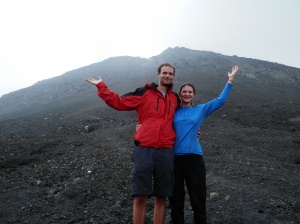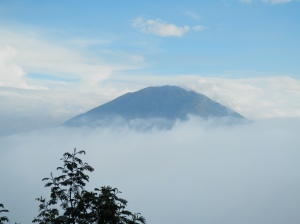“Eruption! Please climb back down…quickly. The experts say there could be a bigger eruption later today.”
Had I not been milliseconds from plummeting 100 feet to an early grave moments earlier, this announcement from our guide would have concerned me more than it did. As it was, I had a feeling that the wind was in our sails and nothing could spoil the moment of reaching the top of one of the world’s most active and deadly volcanoes.
It seems there is a pretty good explanation behind the name of Java’s Mount Merapi (‘One Which Throws Fire’): it’s a very active volcano and when it erupts, you don’t think about which camera mode to use for your prized photo or whether you should eat the cereal bar or peanuts. No – you get out of there. Unless you want molten rocks in your face!

So after our momentary euphoria scanning distant Jogja and the seven nearby peaks from Merapi, Lauren and I quickly manoeuvred ourselves on the rocks 50 metres below the rumbling crater rim and surfed our way to the base of the crater. An American couple trekking on their own decided to ignore the Smithsoninan vulcanolgists’ advice by pausing at the rim for photos. Within two minutes, a thick, wet mist had set in and they were stranded atop a 70-degree sandy cliff. Not a good decision!
The Americans were some of the only other people our group passed on the mountain. Like us, most hire a guide for an amazingly reasonable price through the reception of their losmen or homestay, or one of Yogyakarta’s tour agents on JL Sosro. This affords the peace of mind that you have experienced supervisors who know where they are going and which paths are the safest.
We paid 250,000 IDR ($20) each to a company called Alaska Tours and were picked up from our accommodation at 10pm. After a two-hour drive to Selo village and a one-hour tea break “to acclimatise” (nonsense) to the altitude, we set off with our guide and fellow trekker James and another group consisting of two ladies from Singapore, also in their twenties, who had recently climbed Mount Rinjani in Lombok – our ultimate goal for which Merapi served as a practice run.
After ascending a very steep village road for 20 minutes, we hit a trail and spent the next two hours winding our way around the volcano along narrow and fairly dense forest. For the most part, this section was easy, although I had to concentrate on my footing as one slip could prove fatal where the path occasionally narrowed and you became very aware of your frightening vulnerability in the dark. A drink break every hour along the way broke up the climb and allowed time to catch our breath, refuel or put on more clothing.
The second half of the climb was tougher. Initially, the path became slightly steeper but, all of a sudden, there was no more vegetation…just scree and sand scattering exposed and windy mountain paths. Now we could see our final destination majestically come into focus on the horizon, beyond three plateaus. An hour later, at 5am, we prepared for a final climb to reach the top, 2,900 metres above sea level.
Putting on our fleeces, hats and gloves to stave off the cold (the temperature suddenly dropped up there to 10C), we slowly but surely traipsed up the large grey sand dune which separated us from glory. Just as I was becoming comfortable with this dune, the guide advised us to veer left onto the large area of boulders as he felt the dune would be too steep to mount. This made me nervous as I was not expecting to use my hands much, having read many other bloggers’ descriptions of the trek. Although Lauren took to this task with confidence, I couldn’t help but glance over my shoulder. Having set the pace at the front of our group for four hours, I now felt just as vulnerable as our friends from Singapore who seemed to be scared out of their minds, even with the guide right by their sides watching every move.
A brief lapse in concentration and I had lost my grip and was gripped with fear. I thought briefly about the plaque we passed moments earlier paying tribute to four locals who fell to their deaths from the same spot in 2011. Our guide noticed my dilemma and attempted to reach me before I fell. Thankfully, I spotted a small notch on a rock to my left and steadied myself. I breathed heavily and composed myself. That’s when we heard the rumble and decided it was time to turn around.

When we had distanced ourselves from the crater, we exhaled, had a snack and finally managed to take some decent photos of our surroundings: bright-eyed farmers working their vegetable patches, clouds falling and rising and quickly passing between peaks and villages sprawling away from Merapi and towards Jogja. With some muscle fatigue setting in and the paths below us slickened by the morning drizzle, we carefully tiptoed back down to a very welcome banana and chocolate pancake and tea back at our guide’s house.
In truth, the trek was easier than the hellish slog fraught with all kinds of perils that kept us awake the previous afternoon when we attempted to doze off for a while and forget about what was ahead. The guides were reliable if uncommunicative and the path was fairly well maintained but not always obvious. Physically, our experienced Welsh companion was adamant it was significantly more draining than Mount Kinabalu and the two girls who defeated Rinjani clearly struggled towards the end.

So that’s the first of four Indonesian treks successfully negotiated. Next up is Bali’s Mount Agung, our final preparation for Lombok’s Mount Rinjani which we’ll tackle between 4 and 8 April. We finish with Mount Batur, which should be a more carefree jaunt to witness a spectacular sunset.
Some tips:
-Wear decent hiking boots. End of story.
-Bring at least 1.5l of water per person and some high energy snacks.
-Don’t rely on the headtorches provided – if you have a good one, bring it.
-A raincoat and fleece are essential, hat and gloves will make life easier.
-I’m not sure sunblock or insect repellent are essential – we took both but used neither.
-If you don’t use a guide, tell someone at your accommodation where you are going.
-Expect a tough climb but try to enjoy it, whether the views are spectacular or not. Don’t expect to reach the absolute summit or take any phenomenal photos as the volcano Iis volatile and the weather changes very quickly.
One thought on “Mount Merapi: Climbing One Of The World’s Deadliest Volcanoes”